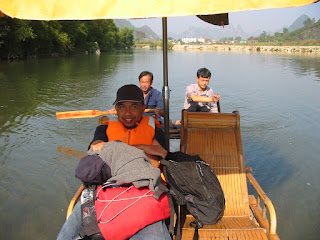We landed in Guangzhou with the kind of excitement that hums just under the skin—no itinerary beyond the first night, just two backpacks, a pocketful of yuan, and the unshakable sense that something unforgettable was about to begin.
From the window of our room at the White Swan Hotel, the Pearl River glittered in the twilight. The Haizhu Bridge, a graceful iron arc, stretched across the water like a threshold between the old and the new. The city pulsed below us—neon signs flickering, ferries sliding across the current, and the scent of street food floating up like a welcome.
It was our first taste of China, and it was deliciously overwhelming.
A ferry carried us to Wuzhou, where we boarded an overnight bus with reclining seats and threadbare curtains, rocking us through the darkness toward the countryside. When we opened our eyes, we were in Yangshuo—a small town cradled by surreal limestone peaks that rose like dragons from the earth.
We found a room, dropped our bags, and immediately headed for the water.
Rafting the Yulong River was like drifting through a living scroll painting. We sat on bamboo rafts as the oarsman guided us through still waters lined with weeping willows and rice fields. Karst mountains mirrored themselves in the river, their reflections broken only by the occasional heron or ripple from our raft. The world fell silent, and we let it.
In Guilin, we continued by bike through meandering roads, past lotus ponds and mountain backdrops that felt too cinematic to be real. We feasted on freshly made rice noodles and wandered through markets that offered everything from dried star anise to live turtles. It was chaotic, rich, textured—and we were all in.
We arrived in Kunming next, the “City of Eternal Spring.” The name fit. Flowers bloomed everywhere, and a lightness hung in the air. At the Western Hills, we climbed toward the Dragon Gate, a stone tunnel carved into a cliff high above Dianchi Lake. Below us, the lake sparkled. Behind us, the mountain whispered its ancient secrets.
At the Stone Forest in Shilin, limestone towers rose like petrified trees—silent sentinels from another era. We wandered through them in awe, feeling both humbled and oddly protected.
Dali greeted us with serenity. The Three Pagodas stood tall and immovable, their reflections dancing in the lake. We wandered by the Qingbi Stream, watched clouds kiss the Cangshan Mountains, and climbed to the Chessboard Ridge, where the breeze carried the scent of pine and the sounds of temple bells from far below.
Local Bai women welcomed us with smiles and strong tea. We didn’t speak the same language, but somehow it didn’t matter.
Then came Lijiang, ancient and luminous. The old town unfolded in wooden bridges and cobbled streets, a place where music drifted from second-story balconies and lanterns lit the night.
At Mu Mansion, we stepped through a grand Chinese gate into a world of carved beams, stone lions, and imperial echoes. At the Dongba Cultural Park, we learned of the Naxi people, their sacred scripts and deep connection to nature.
Just outside town, Jade Dragon Snow Mountain appeared—majestic and still, its peak wrapped in mist. At its foot, terraced pools shimmered turquoise in the sunlight. We didn’t climb it. We just stood there and stared, letting it take our breath.
But none of this prepared us for what came next.
Tiger Leaping Gorge.
Back then, it wasn’t the Instagram darling it is today. It was wild, raw, and barely marked on the map we’d bought from a street vendor. Our driver dropped us off at a dusty clearing and said, “This is the trailhead. I’ll wait here.”
We had one bottle of water, no guide, and an optimistic belief that we’d make it back by sundown. The trail disappeared into the cliffs, and we followed it—blindly, eagerly.
What unfolded was something mythic.
The Yangtze River thundered below, carving the gorge with a force that felt prehistoric. The trail clung to the mountain’s edge, often little more than a goat path. We crossed waterfalls barefoot, scrambled over boulders, ducked under rock overhangs. We passed no other hikers—just the occasional farmer or goat.
By midday, we stood at the edge of the cliff, looking down at the legendary Tiger Leaping Rock, where myth says a tiger once leapt across the chasm to escape a hunter. I could almost see it. The air there was different—charged with something that made us quiet, reverent.
It was deja vu in the wild, like we had been here before in some other life.
We returned exhausted and elated. Changed.
From there, we made our way to Xishuangbanna, a lush and tropical borderland of banana trees, gold-tipped Dai temples, and incense smoke rising through the jungle. The rhythms slowed again. We shared meals with strangers who became friends, learned to drink tea without a word, and sat under stars that looked bigger than they ever had back home.
And finally—Sanya, in Hainan Dao. The end of our journey, where the sea stretched endlessly, and the sun turned everything gold. We swam, we rested, we reflected.
This wasn’t a vacation. It was a transformation.
We came home sunburnt, dusty, journal pages filled and hearts cracked open. The trip didn’t answer anything—we hadn’t set out looking for answers—but it gave us stories.
And sometimes, stories are more than enough.






































Comments
Post a Comment